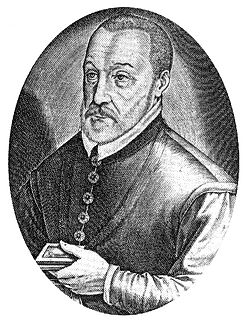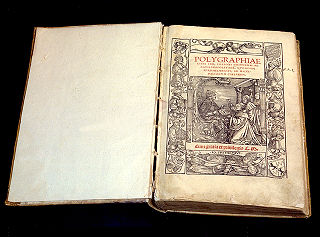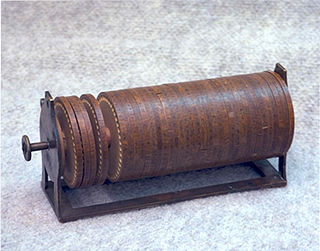
Cryptanalysis refers to the process of analyzing information systems in order to understand hidden aspects of the systems. Cryptanalysis is used to breach cryptographic security systems and gain access to the contents of encrypted messages, even if the cryptographic key is unknown.

The Vigenère cipher is a method of encrypting alphabetic text by using a series of interwoven Caesar ciphers, based on the letters of a keyword. It employs a form of polyalphabetic substitution.
In cryptography, coincidence counting is the technique of putting two texts side-by-side and counting the number of times that identical letters appear in the same position in both texts. This count, either as a ratio of the total or normalized by dividing by the expected count for a random source model, is known as the index of coincidence, or IC for short.

William Frederick Friedman was a US Army cryptographer who ran the research division of the Army's Signal Intelligence Service (SIS) in the 1930s, and parts of its follow-on services into the 1950s. In 1940, subordinates of his led by Frank Rowlett broke Japan's PURPLE cipher, thus disclosing Japanese diplomatic secrets before America's entrance into World War II.

Books on cryptography have been published sporadically and with highly variable quality for a long time. This is despite the tempting, though superficial, paradox that secrecy is of the essence in sending confidential messages — see Kerckhoffs' principle.

Elizebeth Smith Friedman was an American expert cryptanalyst and author. She has been called "America's first female cryptanalyst".
In cryptography, the ADFGVX cipher was a manually applied field cipher used by the Imperial German Army during World War I. It was used to transmit messages secretly using wireless telegraphy. ADFGVX was in fact an extension of an earlier cipher called ADFGX which was first used on 1 March 1918 on the German Western Front. ADFGVX was applied from 1 June 1918 on both the Western Front and Eastern Front.
In cryptanalysis, Kasiski examination is a method of attacking polyalphabetic substitution ciphers, such as the Vigenère cipher. It was first published by Friedrich Kasiski in 1863, but seems to have been independently discovered by Charles Babbage as early as 1846.

The Jefferson disk, also called the Bazeries Cylinder or wheel cypher as named by Thomas Jefferson, is a cipher system using a set of wheels or disks, each with the 26 letters of the alphabet arranged around their edge. The order of the letters is different for each disk and is usually scrambled in some random way. Each disk is marked with a unique number. A hole in the center of the disks allows them to be stacked on an axle. The disks are removable and can be mounted on the axle in any order desired. The order of the disks is the cipher key, and both sender and receiver must arrange the disks in the same predefined order. Jefferson's device had 36 disks. [Kahn, p. 194]
Bacon's cipher or the Baconian cipher is a method of steganographic message encoding devised by Francis Bacon in 1605. A message is concealed in the presentation of text, rather than its content.
Below is a timeline of notable events related to cryptography.
Codes and ciphers were used extensively in World War I. The decoding by British Naval intelligence of the Zimmermann telegram helped bring the United States into the war.

Elizabeth Wells Gallup was an American educator and exponent of the Baconian theory of Shakespearean authorship.

Cryptography, or cryptology, is the practice and study of techniques for secure communication in the presence of adversarial behavior. More generally, cryptography is about constructing and analyzing protocols that prevent third parties or the public from reading private messages; various aspects in information security such as data confidentiality, data integrity, authentication, and non-repudiation are central to modern cryptography. Modern cryptography exists at the intersection of the disciplines of mathematics, computer science, electrical engineering, communication science, and physics. Applications of cryptography include electronic commerce, chip-based payment cards, digital currencies, computer passwords, and military communications.

Fabyan Villa was the home of George and Nelle Fabyan from c. 1908 to 1939. The house is notable because of its remodelling in 1907 by Frank Lloyd Wright. It was the centerpiece of the Fabyans country estate, which they named Riverbank. The Kane County Forest Preserve District of Illinois purchased the majority of the Fabyan estate in 1939, and operated the Fabyans' home as a museum off and on beginning in 1940. In 1995 Preservation Partners of the Fox Valley was enlisted to operate the site and developed the Fabyan Villa Museum into a Fabyan historic home museum, where photographs, the Fabyans' personal artifact collections, and a limited number of original furnishings, as well as the Riverbank story are shared with the public.

"Colonel" George Fabyan was a millionaire businessman who founded a private research laboratory. Fabyan's laboratory pioneered modern cryptography, though its initial findings, supporting Fabyan's belief that Francis Bacon wrote Shakespeare's plays, were later disproven by the cryptographers who trained there.

Riverbank Acoustical Laboratories (RAL),, is a NVLAP accredited acoustical testing agency founded by George Fabyan in 1913.
ʻAfīf al-Dīn ʻAlī ibn ʻAdlān al-Mawsilī, born in Mosul, was an Arab cryptologist, linguist and poet who is known for his early contributions to cryptanalysis, to which he dedicated at least two books. He was also involved in literature and poetry, and taught on the Arabic language at the Al-Salihiyya Mosque of Cairo.











